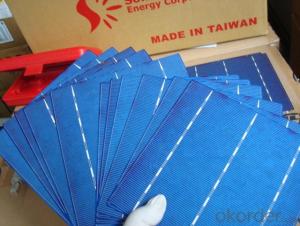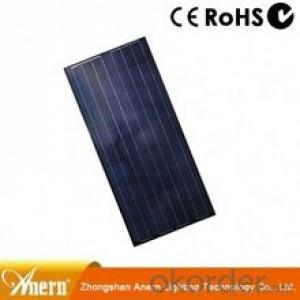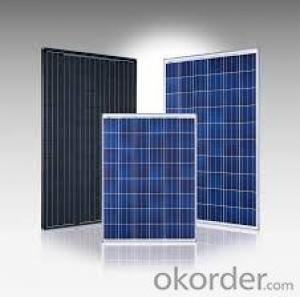Polycrytalline Solar Cells-Tire 1 Manufacturer-Effy 16.4%
- Loading Port:
- Shanghai
- Payment Terms:
- TT OR LC
- Min Order Qty:
- 10000 pc
- Supply Capability:
- 50000000 pc/month
OKorder Service Pledge
OKorder Financial Service
You Might Also Like
Brief Introduction of Solar Cells
A solar cell, is an electrical device that converts the energy of light directly into electricity by the photovoltaic effect, which is a physical and chemical phenomenon. It is a form of photoelectric cell, defined as a device whose electrical characteristics, such as current, voltage, or resistance, vary when exposed to light. Solar cells are the building blocks of photovoltaic modules, otherwise known as solar panels.
Specifications of Polycrystalline Solar Cells
Format : 156 mm × 156 mm ± 0.5 mm
Thickness: 210 μm ±40 μm
Front (-) : 1.5mm bus bars (silver),blue anti-reflection coating (silicon nitride)
Back (+) : 2.5mm wide soldering pads (silver) back surface field (aluminium)
Efficiency (%) | Pmpp (W) | Umpp (V) | Impp (A) | Voc (V) | Isc (A) |
18.00% | 4.38 | 0.528 | 8.291 | 0.631 | 8.869 |
17.80% | 4.33 | 0.525 | 8.252 | 0.629 | 8.821 |
17.60% | 4.29 | 0.532 | 8.053 | 0.633 | 8.541 |
17.40% | 4.23 | 0.528 | 8.092 | 0.624 | 8.632 |
17.20% | 4.19 | 0.524 | 7.992 | 0.62 | 8.458 |
17.00% | 4.14 | 0.52 | 7.972 | 0.623 | 8.5 |
Advantage of Polycrystalline Solar Cells
1. Tire-1 Solar Cells’ Manufacturer Quality Guarantee. With a complete and sophisticated quality government system, our Quality Management have arrived world’s leading place. Customer can receive Tire-1 Cells Maker’s Quality Standard Products.
2. Trusted Warranty. We supply good after-sales to our customers. Any defects which is not comply with our quality standard, can be claimed by our customers.
3. World wide market: Now we have explored wide customer group over the world. Now we have customers in Asia, like India, Philippines, Thailand, Japan. Europe like German, UK, France, Italy etc. And also North and South America are also important area.
4. Stable Supply of Solar Cells. With the capacity of 500MW, we can supply a stable quantity to the world.
Usage of Polycrystalline Solar Cells
Solar cells are often electrically connected and encapsulated as a module. Photovoltaic modules often have a sheet of glass on the front (sun up) side, allowing light to pass while protecting the semiconductor wafers from abrasion and impact due to wind-driven debris, rain, hail, etc. Solar cells are also usually connected in series in modules, creating an additive voltage. Connecting cells in parallel will yield a higher current; our solar cells have passed IEC Certification. With high and stable quality, our cells can greatly improve the performance of Solar Modules.
Applications of Polycrystalline Solar Cells
Assemblies of photovoltaic cells are used to make solar modules which generate electrical power from sunlight, as distinguished from a "solar module" or "solar panel". A solar array generates solar power using solar energy.
Packaging & Delivery of Polycrystalline Solar Cells
Carton Box Package and Deliver by air. It should be noticed that it should be avoid of water, sunshine and moist.
Factory Picture of Solar Cells

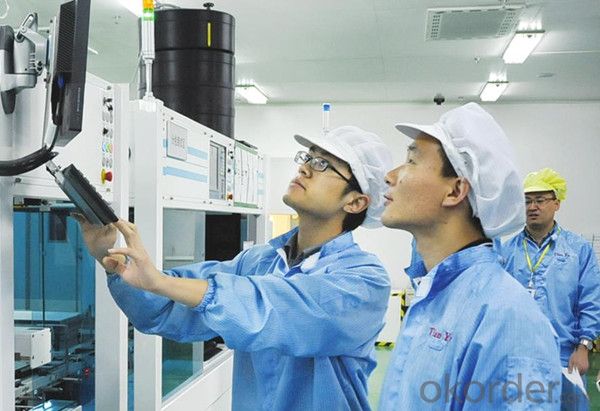
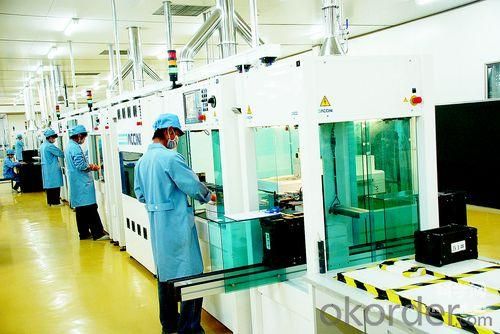
FAQ
We have organized several common questions for our clients,may help you sincerely:
1. What’s price per watt?
A: It’s depends on the quantity, delivery date and payment terms of the order. We can talk further about the detail price issue. Our products is high quality with lower price level.
2. Can you tell me the parameter of your solar cells?
We have different series of cells with different power output, both from c-si to a-si. Please take our specification sheet for your reference.
3. How do you pack your products?
We have rich experience on how to pack the panels to make sure the safety on shipment when it arrives at the destination.
4. Can you do OEM for us?
Yes, we can.
5. How long can we receive the product after purchase?
In the purchase of product within three working days, We will arrange the factory delivery as soon as possible. The perfect time of receiving is related to the state and position of customers. Commonly 7 to 10 working days can be served.
- Q:What is the impact of dust storms on solar cell efficiency?
- Dust storms have a significant negative impact on solar cell efficiency. The accumulation of dust on the surface of solar panels reduces the amount of sunlight that can reach the cells, leading to a decrease in power generation. The dust particles block and scatter sunlight, reducing the overall efficiency of converting sunlight into electricity. Regular cleaning and maintenance of solar panels are necessary to mitigate the adverse effects of dust storms and ensure optimal performance.
- Q:Can solar cells be used for powering offshore oil rigs?
- Yes, solar cells can be used for powering offshore oil rigs. They provide a sustainable and reliable source of energy, reducing the reliance on fossil fuels and minimizing the environmental impact. Additionally, advancements in solar technologies have made them more efficient and capable of withstanding harsh offshore conditions, making them a viable option for offshore oil rig power generation.
- Q:What is the impact of wind on solar cell efficiency?
- The impact of wind on solar cell efficiency is generally negative. Strong winds can create turbulence around solar panels, causing them to vibrate or move, which can potentially damage the cells or the overall system. Additionally, excessive wind can lead to dust and debris accumulation on the surface of the panels, reducing their ability to absorb sunlight and convert it into electricity efficiently. Therefore, it is important to consider the effects of wind and implement proper measures, such as secure mounting and regular cleaning, to minimize any negative impact on solar cell efficiency.
- Q:What is the usage of solar cells?
- Solar cells can be used in many different places, such as the power supply factories.
- Q:How are solar cells integrated into building designs?
- Solar cells can be integrated into building designs in several ways. One common method is to install solar panels or modules on the roof, which capture sunlight and convert it into electricity. These panels can be mounted on top of the roof or integrated into the roofing material itself. Another approach is to incorporate solar cells into windows or building facades, creating solar glazing that generates electricity while still allowing natural light to enter the building. Additionally, solar cells can be integrated into shading devices such as awnings or louvers, providing both energy generation and sun control. Overall, integrating solar cells into building designs allows for the efficient utilization of renewable energy and reduces dependency on traditional power sources.
- Q:Why and what is the low efficiency solar cell?
- I do know when the energy is absorbed by the solar cell, there will be loss in the conversion, that is one of the reason that the solar cell becomes low efficient.
- Q:Can solar cells be used in disaster recovery efforts?
- Yes, solar cells can be used in disaster recovery efforts. They provide a reliable and sustainable source of electricity, which is crucial in disaster-stricken areas where power infrastructure may be damaged or inaccessible. Solar cells can be used to power emergency communication systems, medical equipment, lighting, and charging stations for essential devices. They are portable, easy to deploy, and can significantly contribute to the relief and recovery efforts in disaster-affected regions.
- Q:How do solar cells affect the value of a property?
- Solar cells can positively affect the value of a property by reducing energy costs, generating income through net metering or feed-in tariffs, and increasing its overall sustainability and appeal to potential buyers.
- Q:How do solar cells work to become the solar energy?
- The solar cells need to work by converting a certain material into another useful energy. That's how we can utilize the solar energy into our life and factories.
- Q:How do solar cells perform in areas with high levels of air pollution?
- Solar cells can experience a decrease in performance in areas with high levels of air pollution due to reduced sunlight reaching the surface of the cells. The presence of pollutants in the atmosphere can block or scatter sunlight, leading to a decrease in the amount of energy that can be converted by the solar cells.
1. Manufacturer Overview |
|
|---|---|
| Location | |
| Year Established | |
| Annual Output Value | |
| Main Markets | |
| Company Certifications | |
2. Manufacturer Certificates |
|
|---|---|
| a) Certification Name | |
| Range | |
| Reference | |
| Validity Period | |
3. Manufacturer Capability |
|
|---|---|
| a)Trade Capacity | |
| Nearest Port | |
| Export Percentage | |
| No.of Employees in Trade Department | |
| Language Spoken: | |
| b)Factory Information | |
| Factory Size: | |
| No. of Production Lines | |
| Contract Manufacturing | |
| Product Price Range | |
Send your message to us
Polycrytalline Solar Cells-Tire 1 Manufacturer-Effy 16.4%
- Loading Port:
- Shanghai
- Payment Terms:
- TT OR LC
- Min Order Qty:
- 10000 pc
- Supply Capability:
- 50000000 pc/month
OKorder Service Pledge
OKorder Financial Service
Similar products
New products
Hot products
Hot Searches
Related keywords


